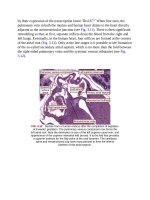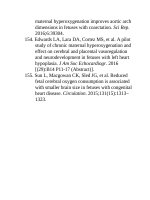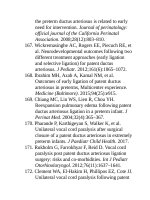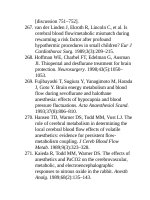Andersons pediatric cardiology 1849
Bạn đang xem bản rút gọn của tài liệu. Xem và tải ngay bản đầy đủ của tài liệu tại đây (134.3 KB, 3 trang )
■Evaluationofthecentralnervoussystem
■Feedingandnutrition
■Deviationsfromtheexpectedpostoperativecourse
■Evaluationandmanagementofacutedecompensation
■Evaluationandmanagementoffailuretoprogress
■Familysupportanddischargeplanning
BedsidePreparedness
Preparationforthearrivalofaneonatefollowingsurgicalinterventionstartswell
beforethechild'sarrivalattheCICU,andcommunicationwiththeteaminthe
operatingroompriortopatientarrivaliscritical.Handofffromtheoperating
roomtotheCICUmarksaperiodofparticularlyincreasedvulnerability.An
understandingoftheventilationstrategies,monitoringlines,vasoactive
medications,surgicalconsiderations(suchasdelayedsternalclosureand
bleeding)isvital,asisexcellentcommunicationamongthemembersofthe
team.Eachinstitutionwillutilizedifferentstrategiesdependingonunit
experienceaswellaspoliciesandprocedures,althoughastandardizedapproach
toenvironmentalpreparedness,equipmenttransfer,andinformationhandoffis
criticaltooptimizetransitionalcare.Importantelementsofenvironmental
readinessareshowninTable71.3.
Table71.3
EnvironmentalReadiness
StandardEquipment
Ventilator
Heat/warmingsource
Monitor
Infusionpumps
Suctionsources
Chestdrainagesystem(e.g.,Pleurevac)
Medications
Vasoactivemedications
Sedationandanalgesia
Neuromuscularblockade(if
used)
Resuscitationmedications
EmergencyEquipment
Defibrillator
Codeorcrashcart
Sternalopeningtray
Extracorporealmembraneoxygenation
circuit
Airwayprotectionandintubation
equipment
InvasiveandNoninvasiveMonitoringand
Surveillance
MonitoringandsurveillanceoftheneonatewithafUVHfollowingcomplex
palliativesurgeryplaysacrucialroleinassessmentandmanagement.
Monitoringcanbecontinuous(e.g.,heartrate)orintermittent(e.g.,renal
function),andinvasive(e.g.,centralvenouspressure)ornoninvasive(e.g.,
electroencephalography).Valuesobtainedgenerallyrepresentanactualvalue
(e.g.,pH),butaloneorincombinationallaresurrogatesfortheadequacyof
DO2,multiorganhealth,andthe“pace”ofrecovery.Eachcentertypicallyhasa
standardizedstrategy,althoughtherearesignificantdifferencesamong
centers.12,14,16,105–110AsummaryofvariousprotocolscanbefoundinTable
71.4(continuousmonitoring)andTable71.5(intermittentmonitoring).
Table71.4
Institution-SpecificApproachestoMonitoringAfterNeonatal
PalliationofFunctionallyUniventricularHearts
BostChild
STAGEINORWOOD
Invasive
Centralvenous
Yes
cathetera
Umbilicalvenous
Sometimes
catheter
Umbilicalarterial
Sometimes
catheter
Peripheralarterial
Yes
catheter
Atrialcatheter
Yes
Urinarycatheter
Yes
Noninvasive
Electroencephalogram Sometimes
CerebralNIRS
Yes
SomaticNIRS
No
End-tidalCO2b
Yes
Temperature
CHOP
CNMC
No
CCHMC
RCH
CSMott
BirmChild
Sometimes Yes
No
No
No
Yes
Yes
Sometimes Yes
Sometimes Yes
Yes
No
Yes
Sometimes Yes
Sometimes Yes
Yes
No
Sometimes Sometimes Yes
Sometimes Yes
Sometimes Yes
Yes
Yes
Yes
Yes
Yes
Yes
Yes
Yes
Yes
Yes
Yes
Yes
Sometimes
Yes
Yes
No
No
Yes
Yes
Yes
Yes
Yes
Sometimes
Yes
Yes
Yes
Sometimes
Yes
Yes
Yes
No
Yes
Yes
Yes
No
Yes
Sometimes
Yes
No
Sometimes
Sometimes
Yes
Esophagus Yes
Bladder
Skin
Multi-Site
Yes
Yes
No
Yes
Yes
Yes
Yes
Yes
No
Yes
Yes
Yes
MultiSite
Yes
Yes
No
Yes
Yes
Yes
Yes
Yes
No
No
Yes
Yes
No
N/A
No
Yes
Yes
Sometimes Yes
Sometimes
Yes
No
Yes
Sometimes Yes
Sometimes
Yes
No
Esophagus Rectal
Heartrate
Yes
Respiratoryrate
Yes
iDO2
Yes
HYBRIDPROCEDURE
Invasive
Centralvenous
Yes
catheter*
Umbilicalvenous
Sometimes
catheter
Umbilicalarterial
Sometimes
TCH
catheter
Peripheralarterial
catheter
Atrialcatheter
Urinarycatheter
Noninvasive
Electroencephalogram
CerebralNIRS
SomaticNIRS
End-tidalCO2b
Yes
Sometimes Sometimes Yes
Sometimes
Sometimes Yes
Yes
Yes
Sometimes Yes
Yes
Yes
Yes
Yes
Yes
Yes
Yes
Yes
Sometimes
Yes
Sometimes
Yes
No
Yes
No
No
No
Yes
No
Yes
Yes
Yes
Sometimes N/A
Yes
Yes
Yes
No
Yes
Sometimes
Yes
No
Sometimes
Sometimes
Yes
Yes
Yes
Yes
No
Bladder
Yes
Yes
Yes
No
Skin
Yes
Yes
Yes
Multisite
Yes
Yes
No
Yes
Yes
Yes
Yes
Yes
Yes
Yes
No
Yes
No
Yes
No
Yes
Sometimes
Yes
Yes
Yes
Yes
Yes
Yes
Yes
Yes
Yes
Yes
Yes
Yes
Yes
Yes
Yes
Yes
Sometimes
Sometimes No
Yes
Yes
Temperature
Sometimes Rectal
Esophagus Yes
Heartrate
Yes
Yes
Yes
Yes
Respiratoryrate
Yes
Yes
Yes
Yes
iDO2
Yes
No
Yes
No
TOTALCAVOPULMONARYCONNECTION(FONTAN)
Invasive
Fontanlinec
Yes
Sometimes Yes
Yes
Commonatrial
Yes
Yes
Yes
Yes
catheter
Peripheralarterial
Yes
Yes
Yes
Yes
catheter
Urinarycatheter
Yes
Yes
Yes
Yes
Noninvasive
CerebralNIRS
Sometimes No
Yes
Yes
SomaticNIRS
No
No
Yes
Yes
End-tidalCO2b
Yes
Yes
Yes
Yes
Bladder
Yes
Yes
Yes
Multisite
Yes
Yes
No
Skin
Yes
Yes
Yes
Multisite
Yes
Yes
No
Yes
No
Yes
No
Yes
Yes
Yes
Yes
Yes
Yes
Yes
Yes
Yes
Yes
Yes
Yes
Yes
Yes
Yes
Yes
Yes
Yes
Yes
No
Sometimes No
Yes
Yes
Temperature
Heartrate
Respiratoryrate
iDO2
Bladder
Yes
Yes
Yes
Multisite
Yes
Yes
No
Skin
Yes
Yes
Yes
No
Yes
Yes
Yes
Temperature
Esophagus Rectal
Esophagus
Heartrate
Yes
Yes
Yes
Respiratoryrate
Yes
Yes
Yes
iDO2
Yes
No
Yes
SUPERIORCAVOPULMONARYCONNECTION
Invasive
Centralvenous
Yes
No
No
catheter*
Atrialcatheter
Yes
Yes
Yes
Peripheralarterial
Yes
Yes
Yes
catheter
Urinarycatheter
Yes
Yes
Yes
Noninvasive
CerebralNIRS
Yes
No
Yes
SomaticNIRS
No
No
Yes
End-tidalCO2b
Yes
Yes
Yes
Sometimes
Yes
Yes
Yes
No
Yes
Yes
No
Esophagus
Yes
Yes
Yes
Yes
Yes
Yes
No
aSuperiorcavalvein.
bWhileintubated.
cSuperiorcavalvein,Fontanbaffle,orpulmonaryartery.
Multisite
Yes
Yes
No









